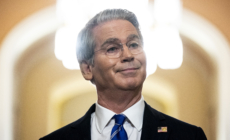-
Aldrich Potgieter Sees Parallels With Scottie Scheffler After First Win - 7 mins ago
-
What to Know About the Heat Wave in Europe - 34 mins ago
-
Trump administration shuts down U.S. website on climate change - 39 mins ago
-
Hotel Guest Takes Photo at 3am, Internet Outraged by What They Find - 41 mins ago
-
Cat Follows Kids to School—What the Principal Does Next Is Perfect - about 1 hour ago
-
Wimbledon 2025: How the World’s Oldest Tennis Tournament is Coping with the Heat Wave - about 1 hour ago
-
Inside the L.A. Zoo’s messy $50-million breakup - about 1 hour ago
-
Bessent Gives Blunt Response to Elon Musk Attacks on Trump Bill - 2 hours ago
-
Homelessness declined in Hollywood, but not Skid Row, study finds - 2 hours ago
-
Under a Drone-Swarmed Sky: Surviving in Eastern Ukraine - 2 hours ago
Wall Street’s Slide Resumes as Tariff Anxiety Persists for Investors
Wall Street’s slide resumed on Thursday, another anxiety-induced drop that left the S&P 500 brushing up against a “correction” — a symbolic marker of the speed at which investors have fled the stock market in recent weeks.
Traders, economists and business leaders have been grappling with a rapidly shifting economic landscape as President Trump has imposed and threatened new tariffs on imports that could upend global trade and undermine complex supply chains for big companies.
On Thursday, Mr. Trump threatened to impose 200 percent tariffs on European wine and champagne, one day after the European Union announced retaliatory tariffs on imports of U.S. whiskey and several other American products. The president has already added tariffs on steel and aluminum imports, and a wide swath of products from China.
The S&P 500 fell more than 1 percent on Thursday, a drop that briefly left it about 10 percent below its Feb. 19 peak. A drop of more than 10 percent is called a correction, which on Wall Street serves as a signal that investors have turned pointedly more pessimistic about the market.
The constantly moving goal posts have left investors so rattled that even recent good news about the economy hasn’t had a calming effect. On Thursday a report on weekly unemployment claims came in lower than expected. On Wednesday a better-than-expected reading of the Consumer Price Index had briefly helped bolster stocks.
Investors are worried that tariffs, once in full effect, will push prices higher — hurting business and consumers. Mr. Trump’s immigration policies and firings of federal employees through the so-called Department of Government Efficiency are also looming in the backdrop.
“The outlook for inflation depends more on tariffs, deportations and DOGE than the backward-looking data releases right now,” Bill Adams, chief economist for Comerica Bank, said on Thursday.



















